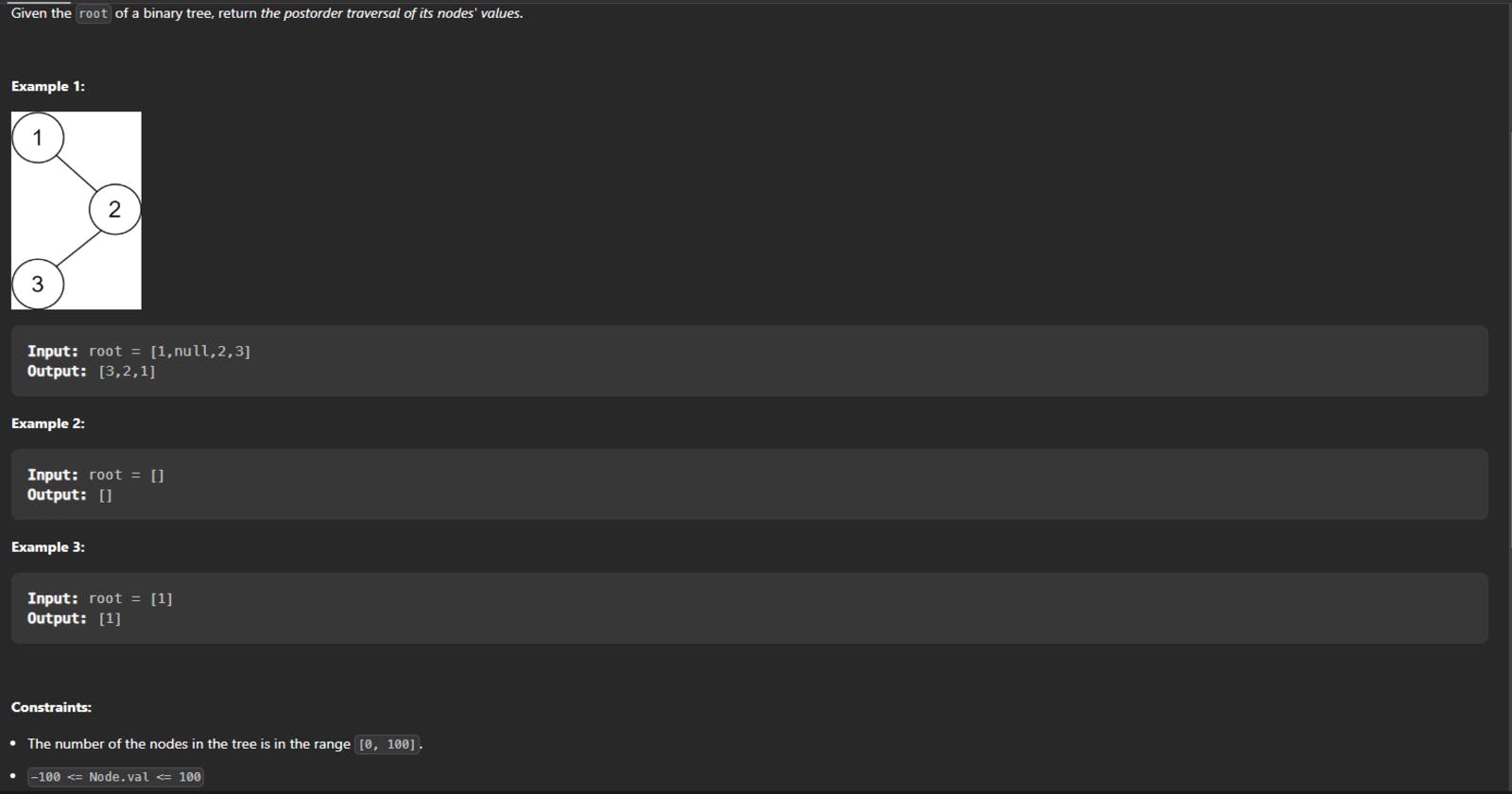Daily Dose of DSA - Day 24
B.T Postorder Traversal using Recursion (TC:O(n) & SC:O(n)(call stack)) & Stack with Iteration (TC:O(n) & SC:O(2n)(2 stack)& SC: O(n)(1 stack))
Question Link: https://leetcode.com/problems/binary-tree-postorder-traversal/description/
Using Recursion :
It uses a helper function,
postorder, to perform the traversal recursively.The
postorderfunction visits the left subtree, then the right subtree, and finally appends the current node's value to the result vector.The
postorderTraversalfunction calls thepostorderfunction to perform the traversal and returns the resulting postorder traversal sequence as a vector.
/**
* Definition for a binary tree node.
* struct TreeNode {
* int val;
* TreeNode *left;
* TreeNode *right;
* TreeNode() : val(0), left(nullptr), right(nullptr) {}
* TreeNode(int x) : val(x), left(nullptr), right(nullptr) {}
* TreeNode(int x, TreeNode *left, TreeNode *right) : val(x), left(left), right(right) {}
* };
*/
class Solution {
public:
vector<int> ans;
void postorder(TreeNode* root)
{
if(root==NULL) return;
postorder(root->left);
postorder(root->right);
ans.push_back(root->val);
}
vector<int> postorderTraversal(TreeNode* root) {
postorder(root);
return ans;
}
};
Using 2 Stack with Iteration :
The
postorderTraversalfunction takes the root of the binary tree as input and returns a vector containing the postorder traversal sequence.It uses two stacks,
st1andst2, to store the nodes during the traversal.Initially, the root is pushed onto
st1.While
st1is not empty, the top node is popped fromst1, pushed ontost2, and its left and right child (if any) are pushed ontost1.Once all the nodes have been traversed and pushed onto
st2, the nodes are popped fromst2one by one, and their values are appended to the result vectorans.
/**
* Definition for a binary tree node.
* struct TreeNode {
* int val;
* TreeNode *left;
* TreeNode *right;
* TreeNode() : val(0), left(nullptr), right(nullptr) {}
* TreeNode(int x) : val(x), left(nullptr), right(nullptr) {}
* TreeNode(int x, TreeNode *left, TreeNode *right) : val(x), left(left), right(right) {}
* };
*/
class Solution {
public:
vector<int> postorderTraversal(TreeNode* root) {
vector<int> ans;
if(root==NULL) return ans;
stack<TreeNode*>st1,st2;
st1.push(root);
while(!st1.empty())
{
root = st1.top();
st1.pop();
st2.push(root);
if(root->left!=NULL) st1.push(root->left);
if(root->right!=NULL) st1.push(root->right);
}
while(!st2.empty())
{
TreeNode* r = st2.top();
ans.push_back(r->val);
st2.pop();
}
return ans;
}
};
Using 1 stack with Iteration :
The
postorderTraversalfunction takes the root of the binary tree as input and returns a vector containing the postorder traversal sequence.It uses a stack
stto store the nodes during the traversal.The code uses a while loop that continues until the stack is empty and the current node is NULL.
In each iteration, it checks if the current node is not NULL. If true, it pushes the current node onto the stack and moves to its left child.
If the current node is NULL, it checks the right child of the top node in the stack. If the right child exists and is not the last visited node, it updates the current node as the right child and continues the loop.
If the right child does not exist or has been visited, it means the traversal of the current subtree is complete. It pops the top node from the stack, adds its value to the result vector, and updates the last visited node.
Finally, it returns the result vector containing the postorder traversal sequence.
/**
* Definition for a binary tree node.
* struct TreeNode {
* int val;
* TreeNode *left;
* TreeNode *right;
* TreeNode() : val(0), left(nullptr), right(nullptr) {}
* TreeNode(int x) : val(x), left(nullptr), right(nullptr) {}
* TreeNode(int x, TreeNode *left, TreeNode *right) : val(x), left(left), right(right) {}
* };
*/
class Solution {
public:
vector<int> postorderTraversal(TreeNode* root) {
vector<int> ans;
if (root == NULL) return ans;
stack<TreeNode*> st;
TreeNode* node = root;
TreeNode* lastVisited = NULL;
while (!st.empty() || node != NULL) {
if (node != NULL) {
st.push(node);
node = node->left;
} else {
TreeNode* x = st.top();
// Check if right child exists and is not visited yet
if (x->right != NULL && x->right != lastVisited) {
node = x->right;
}
else {
ans.push_back(x->val);
lastVisited = x;
st.pop();
}
}
}
return ans;
}
};
